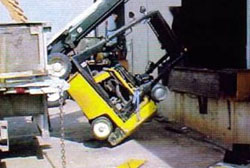 A loading dock worker was loading drywall onto a flatbed truck when a forklift being operated by a co-worker surged forward, fatally pinning him against the truck.
A loading dock worker was loading drywall onto a flatbed truck when a forklift being operated by a co-worker surged forward, fatally pinning him against the truck.
At another workplace, a textile plant supervisor was operating a forklift truck when another forklift fell from a loading dock, causing the supervisor's forklift to flip over. He was crushed under the roll cage and died.
And elsewhere, a warehouse worker died after he was crushed between a reversing semi-trailer and a loading dock. Investigators believe that he was likely paying more attention to the contents of the trailer than to where he was standing.
Loading docks are busy places where machine operators and truck drivers must perform a delicate dance around workers on foot. Along with being congested, loading docks may also be poorly lit, slippery, cramped, crowded with debris, riddled with blind spots and crisscrossed with ramps, stairways and uneven surfaces.
Here are just 5 of the possible hazards:
1. Slips, trips and falls;
2. The possibility of workers on foot being struck by vehicles;
3. Being crushed by unstable loads that shift suddenly;
4. The possibility of a forklift driving over the edge of the dock and having it or its load land on workers below; and
5. The possibility of a trailer whose wheels aren't properly chocked creeping forward or backward into workers.
Loading docks are a hub of activity. Workers need to be trained on how they can protect themselves. If you would like to know more about how R&R is helping keep its clients more safe in this particular area, please contact a knowledge broker.

